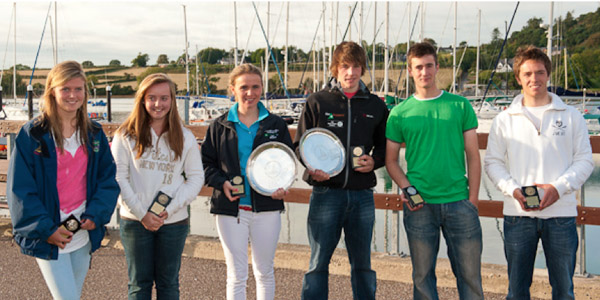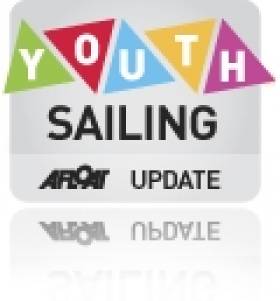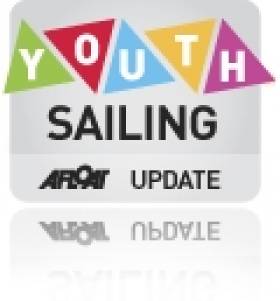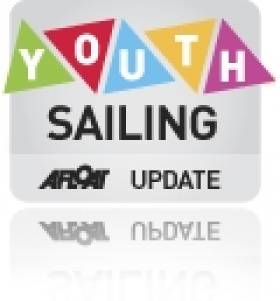Displaying items by tag: Emma Geary
Laser Radial Girl Sophie Murphy is closest to Ireland's goal of sailing to a top ten result at this week's ISAF Youth Worlds in Croatia where conditions at the halfway stage continue to be light and tricky.
The event has added interest for Ireland as it will be staged next year on Dublin Bay, a venue alos know for its flukey winds. The Dublin organiser of the event Brian Craig is in Croatia to monitor progress there.
Murphy scored well in her first of the race of day three with a fourth after having a race win yesterday. She followed that with a 16th and 20th in the 41–strong fleet which leaves her in eleventh position overall going in to the rest day tomorrow.
Cork duo Emma Geary and Niamh Connolly in the 420 finished 17th and 21st today which sees them lying 17th overall.
Philip Doran from Courtown SC in the Laser Radial boys had a disappointing day fininshing 26th overall in the 49 boat fleet. Philip who is no stranger to large international competition (former 4.7 World Champion and the u17 Radial World Champion) remains optimistic and looking forward to a rest day tomorrow before the second half of the event recommences on Wednesday.
300 Top Junior Sailors Bound for Dublin Bay
Over 300 sailors will compete in Dublin Bay in seven different classes (Laser Radial, Laser 4.7, 420, Feva, Topper, SL16 and Optimist). For youth sailors, this event is the most important in the annual calendar as it is the decider for the top Irish sailors to compete internationally during 2011 and is the pathway for future Olympic sailors. Podcast with Olympic Team Manager James O'Callaghan here.
The 420 fleet is already in situ as the Leinster Championships were held over Easter and the girls team Emma Geary and Niamh Connolly won the event in style. This team is the only 420 crew to qualify internationally for a place on the Irish team to compete in the ISAF Youth Worlds in Zadar, Croatia and will be looking to win next weekend to secure this honour.
Dublin Bay will host the 2012 ISAF Youth World Championships and this year's ISA Mitsubishi Youth National event is an important test event with representatives from the international sailing authority visiting Dun Laoghaire to view plans and test logistics.
In addition to the 420 fleet the Laser radial fleet will also be competing to qualify to represent Ireland in Croatia. Philip Doran aged 17 from Courtown in Wexford is the current former under 17 World Champion in the Laser Radial fleet although the National title has eluded him so far. In the girls fleet it will be a toss up between Saskia Tidey (RIYC) and Sophie Murphy (Quoile YC) as both already have a national title each under their belts.
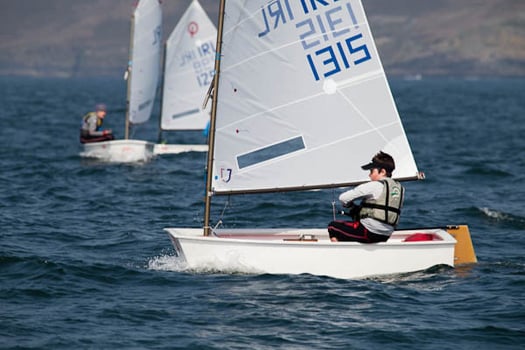
A fleet of top Optimists are expected. Photo: Bob Bateman
The younger Optimist fleet is also celebrating this week after two top 5 positions at the Easter Regatta in Braassemermeer, the Netherlands. In fact an Irish team has competed at this event for 23 years and this is the first time that Ireland has won the country prize. Sean Donnelly from Dun Laoghaire who finished fourth in Braassemermeer is also leading the Optimist fleet in the trials and will be anxious to hold on to first position during the ISA Mitsubishi Youth Nationals.
In other fleets, the laser 4.7 fleet is enjoying record numbers with many ex-Optimist and Topper sailors choosing this boat. Finn Lynch from Blessington and Seafra Guilfoyle from Cork will be firm favourites to win the class.
Overall Dublin Bay will be a spectacle of sail over the May Bank holiday weekend with light winds forecast.
Mitsubishi Motors have been a proud supporter of junior sailing in Ireland for the last 7 years. In recent years Ireland has had successes at youth level with winner of the girls under 21 Laser World Championships and a top 10 at the 2010 ISAF Youth Worlds and wins at the British National Optimist Championships.
Doran Reigns In Junior All Ireland Event
It was a very long day of sailing in very light conditions for the Juniors on the second and final day of the All Ireland Junior Championship writes Claire Bateman. PRO Richard Leonard raced the fleet on the Curlane Bank in Cork harbour and was very fortunate to be able to get in three races in extremely difficult conditions.
The final result saw Philip Doran of Courtown Harbour SC taking first place with Rory Lynch of of Blessington Sailing Club second and Ross Vaughan of
Royal North of Ireland YC third.
In the Girls Fleet Sophie Murphy of Quoile YC took first place with Emma Geary of RCYC second and Katherine Geoghegan of Dungarvan Harbour SC third.
Photos of the Junior All Ireland Prizegiving and competition by Bob Bateman HERE.
